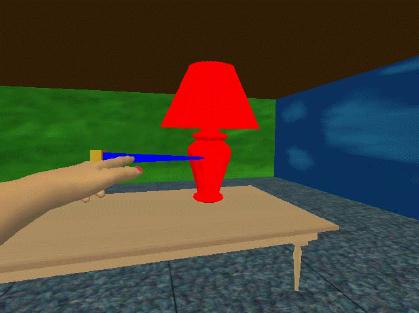Evaluation of Virtual Grabbing/Manipulation Techniques

One of the defining features of immersive virtual reality is the
ability to interact with objects in the virtual world in a natural
manner. Usually this is achieved by using a real-world metaphor:
the user simply reaches out his/her hand, grabs the object, and moves
it around using body, arm, and hand motions.
However, this metahpor is lacking. Users can only manipulate objects
within the arm's reach. To grab other objects, some
travel technique must be used. Positioning
large objects is difficult with this metaphor, since the user must
be so close to them.
Therefore, other techniques are needed. We are researching techniques
which allow grabbing/manipulation of local and remote objects, which
provide complete control over object position and orientation, and which
are efficient and easy-to-use. There are two main categories of techniques.
Arm-Extension Techniques
In this metaphor, the user's virtual arm can be extended or retracted
to grab or position virtual objects. We have implemented and tested
the following techniques:
- Go-Go Technique: The
Go-Go technique was introduced by researchers at the University of
Washington's
Human Interface Technology
Laboratory. When the user's physical hand goes beyond a certain distance
from the body, it begins to grow, following a polynomial function.
- Fast Go-Go Technique: Same as above, except that no threshold
exists for arm extension and the function used grows the arm more quickly.
- Stretch Go-Go Technique: The space around the user's body is
divided into three regions at varying distances. In the middle region,
the virtual arm is stationary. In the outermost region, the arm grows
at a constant rate, and in the innermost region, the arm retracts at
a constant rate. The user is given a gauge to aid in using the technique.
- Indirect Stretching Technique: The user presses joystick
buttons to extend or retract the virtual arm.
Ray-Casting Techniques
In ray-casting, the arm remains at a constant length, and a
virtual light ray extending from the hand is used to pick up and
manipulate objects. When reeling is added, the object's distance
from the user can be controlled by pressing joystick buttons, as in
the indirect stretching technique.
The HOMER Techniques

After testing the above techniques, none proved completely satisfactory.
Ray-Casting techniques made it easy to grab virtual objects, but
manipulation was difficult. Arm-Extension techniques provided natural
and efficient manipulation, but getting the hand in the correct position
to grab objects was hard.
Therefore, we have created new techniques which combine the best
features of the others to produce an easy-to-use, efficient technique
for both grabbing and manipulating remote objects. These are called
the HOMER (Hand-Centered Object Manipulation Extending Ray-Casting)
Techniques.
Here, the user can grab an object using ray-casting, and manipulate
it using natural hand motions. When an object is grabbed, the virtual
hand immediately moves to the object and the object becomes attached
to the hand. To move the object closer or farther away, either joystick
buttons (Indirect HOMER) or a linear mapping of arm motion (Direct
HOMER) may be used. These techniques are easy-to-use, extremely
efficient, and provide complete control over objects' position and
orientation.
Taxonomy of Selection and Manipulation Techniques
This taxonomy attempts to understand the range of possible techniques
by first breaking down the task into subtasks using a task analysis
method. The main subtask branches are selection, manipulation, and
release. Possible techniques for subtasks are also listed. This
taxonomy helps us to think systematically about the tasks involved and
also to see how new techniques might be designed.
Large JPEG image of the taxonomy
Publication:
Bowman, D. and Hodges, L., "An Evaluation of Techniques for
Grabbing and Manipulating Remote Objects in Immersive Virtual
Environments," in the Proceedings of the 1997 Symposium
on Interactive 3D Graphics, 1997.
Download as a Postscript file
Project Participant:
Doug Bowman
Contact Information:
Doug A. Bowman - Graduate Student
Georgia Institute of Technology
College of Computing
Atlanta GA 30332-0280
(404) 894-5104 (Phone)
By E-MAIL :
bowman@cc.gatech.edu

